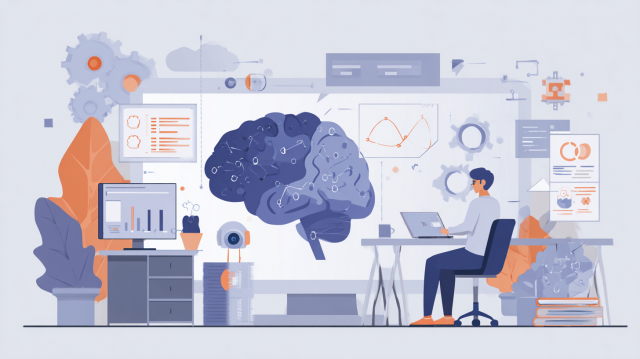
LLMs (Large Language Models) like ChatGPT and Gemini excel at performing a wide range of tasks such as document generation, programming, and information retrieval with high accuracy in response to user prompts that resemble natural speech. However, it is important to note that the generated content is not always guaranteed to be correct. The data that LLMs learn from consists of text data available on the internet, but they do not always learn the most up-to-date information. Additionally, they cannot learn information that is not available online. Due to their nature, LLMs can produce responses that sound plausible even when they are based on incorrect information, a phenomenon known as "hallucination."
In order to promote DX in business, we want to utilize LLMs to improve efficiency and productivity in various operations. However, due to the challenges mentioned above, it is difficult to use existing LLMs as they are. That said, developing an LLM from scratch incurs enormous development costs, making it unrealistic. Therefore, various technologies are being developed to customize existing LLMs and enhance their accuracy. Among these, RAG and fine-tuning are attracting attention.
This time, we will explain the differences between RAG and fine-tuning for customizing LLMs.
- Table of Contents
-
- 1. What is RAG? A Simple Explanation of Its Mechanism, Advantages, and Disadvantages
- 2. What is Fine-Tuning? Explanation of Its Mechanism, Formats, and Characteristics
- 3. What Are the Differences Between RAG and Fine-Tuning? Easy-to-Understand Explanation with a Comparison Table
- 4. Which Should You Choose? A Usage Guide by Use Case
- 5. Human Science Annotation, LLM RAG Data Structuring Agency Service
1. What is RAG? A Simple Explanation of Its Mechanism, Advantages, and Disadvantages
As we have explained in our company blog, RAG stands for Retrieval-Augmented Generation. The mechanism of RAG can be simply described as the LLM searching for information from untrained data (external data) based on the user's input prompt, adding the search results to the prompt, and passing it to the LLM. The LLM generates responses based on this information. A key feature of RAG is that there is no need for additional training of the LLM itself.
Reference Blog
>Explanation of LLM and RAG for Business Utilization of Generative AI
●Benefits
・It is possible to generate responses based on the latest information
RAG searches the information from a dedicated database that stores external data. If the information in this database is updated with the latest information, the LLM's responses can always be generated to cover the most current information.
●Disadvantages
・The accuracy of the response results depends on external data
If there are errors in the database information, that information will be passed to the LLM, resulting in incorrect answers.
・Data organization is necessary
To perform accurate searches with RAG, attention must be paid to the state of the data stored in the database. For example, parts of PDF documents that contain embedded images cannot be searched with RAG. It is important to use text-based Word files before they are converted to images, if available. Additionally, it is essential to structure documents as much as possible and to ensure that the latest version is used when there are multiple versions of a document, as proper data organization is crucial for accurate searches with RAG.
2. What is Fine-Tuning? Explanation of Its Mechanism, Formats, and Characteristics
Fine-tuning is a method of customizing existing LLMs by providing additional training datasets tailored to specific purposes. Fine-tuning itself has been used in deep learning, which mimics neural networks, even before the advent of LLMs. The mechanism involves adding a new layer to the output layer of the neural network and adjusting the parameters across the entire LLM through training with the dataset.
The format of the training dataset varies by LLM. For example, for ChatGPT, the dataset is described in a format such as JSONL with <prompt (question), completion (answer)>.
●Benefits
・Improvement of accuracy for specific domains and tasks
Fine-tuning allows for specialized learning in specific domains due to the way LLMs learn. For example, by focusing on learning specific to the medical field, it becomes possible to operate LLMs with higher accuracy.
●Disadvantages
・Creation of large datasets is necessary
Datasets need to be in a format that can be learned by LLMs. Therefore, it is necessary to create datasets for this purpose, and while the amount cannot be generalized, in some cases, it may require preparing thousands or tens of thousands of data points manually, which takes a tremendous amount of labor.
3. What Are the Differences Between RAG and Fine-Tuning? Easy-to-Understand Explanation with a Comparison Table
Both methods share the commonality of customizing the LLM using external data. The major difference is whether the LLM itself undergoes additional training. In RAG, external data is searched and passed to the existing LLM, so there is no need for additional training. On the other hand, in fine-tuning, the LLM undergoes additional training with external data, resulting in the LLM itself being customized.
The characteristics mentioned so far are summarized below.
| RAG | Fine-tuning | |
|---|---|---|
| LLM Learning | None | Available |
| Training Data | ・Documents stored in the database, etc. | ・Formats that LLM can process |
| Response Generation Method | ・Search the database and generate answers using existing LLM | ・The LLM itself generates responses through additional training |
| Benefits | - Easy updates for the latest information | ・High accuracy of responses for specific domains and tasks |
| Disadvantages | ・If incorrect information is included, accuracy will not be achieved ・Data maintenance is necessary |
- Creation of training datasets is necessary |
There are such differences between RAG and fine-tuning. It cannot be said outright which method is superior. While RAG is suitable for handling the latest information, fine-tuning is more appropriate if you seek deeper accuracy in specific fields of expertise. Therefore, which method is suitable depends on the purpose, so it is important to carefully consider and choose the customization method.
4. Which Should You Choose? A Usage Guide by Use Case
Both RAG and fine-tuning are effective methods for leveraging LLMs combined with external data, but each has its strengths and considerations. RAG excels at searching and utilizing the latest information and can be implemented in a relatively short period. On the other hand, fine-tuning incorporates deep knowledge of specific domains into the model, making it effective in fields and tasks requiring high accuracy, such as medical and legal sectors. Which method is suitable depends on the "nature of the information handled" and the "desired accuracy and operational framework." Below, we compare the two from four perspectives.
Comparison of RAG and Fine-tuning
| Perspective | RAG | Fine-tuning |
|---|---|---|
| Which should be used? | Suitable for cases handling the latest information. Such as news articles and internal knowledge searches. | Effective when you want to deeply address specialized fields. Such as medical, legal, and manufacturing. |
| Examples of learning formats | Vectorize PDFs, Word documents, and FAQs and store them in a search database. | Prepare a large number of "question-answer" pairs in JSONL format, etc., for additional training. |
| Cost and Time Comparison | No retraining required, enabling short-term and low-cost implementation. | Data creation and training require significant effort, resulting in high initial investment and longer duration. |
| Trends Among Implementing Companies | Areas handling the latest information such as media companies and customer support. | Highly specialized fields such as medical, legal, and manufacturing. Hybrid implementations with RAG are also increasing. |
RAG and fine-tuning, as methods for customizing LLMs, each have their own strengths and challenges. While RAG enables speedy and low-cost utilization of the latest information, fine-tuning requires large-scale data preparation but significantly improves answer accuracy in specialized fields. In either case, properly preparing the quality and quantity of external data is the key to success. It is advisable to choose the optimal method according to your company's goals and resources, and sometimes consider a hybrid implementation combining RAG and fine-tuning.
5. Human Science Annotation, LLM RAG Data Structuring Agency Service
Over 48 million pieces of training data created
At Human Science, we are involved in AI model development projects across various industries, starting with natural language processing and extending to medical support, automotive, IT, manufacturing, and construction, just to name a few. Through direct business with many companies, including GAFAM, we have provided over 48 million pieces of high-quality training data. No matter the industry, our team of 150 annotators is prepared to accommodate various types of annotation, data labeling, and data structuring, from small-scale projects to big long-term projects.
Resource management without crowdsourcing
At Human Science, we do not use crowdsourcing. Instead, projects are handled by personnel who are contracted with us directly. Based on a solid understanding of each member's practical experience and their evaluations from previous projects, we form teams that can deliver maximum performance.
Support for not just annotation, but the creation and structuring of generative AI LLM datasets
In addition to labeling for data organization and annotation for identification-based AI systems, Human Science also supports the structuring of document data for generative AI and LLM RAG construction. Since our founding, our primary business has been in manual production, and we can leverage our deep knowledge of various document structures to provide you with optimal solutions.
Secure room available on-site
Within our Shinjuku office at Human Science, we have secure rooms that meet ISMS standards. Therefore, we can guarantee security, even for projects that include highly confidential data. We consider the preservation of confidentiality to be extremely important for all projects. When working remotely as well, our information security management system has received high praise from clients, because not only do we implement hardware measures, we continuously provide security training to our personnel.
In-house Support
We provide staffing services for annotation-experienced personnel and project managers tailored to your tasks and situation. It is also possible to organize a team stationed at your site. Additionally, we support the training of your operators and project managers, assist in selecting tools suited to your circumstances, and help build optimal processes such as automation and work methods to improve quality and productivity. We are here to support your challenges related to annotation and data labeling.

 Text Annotation
Text Annotation Audio Annotation
Audio Annotation Image & Video Annotation
Image & Video Annotation Generative AI, LLM, RAG Data Structuring
Generative AI, LLM, RAG Data Structuring
 AI Model Development
AI Model Development In-House Support
In-House Support For the medical industry
For the medical industry For the automotive industry
For the automotive industry For the IT industry
For the IT industry




























































































